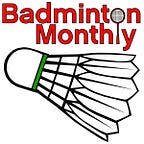Badminton & Friendships — Junior International Trials
BadmintonMonthly.com
Every year, junior players have an opportunity to qualify to become members of junior Team USA to compete in the summer Pan American Junior Championships. Junior International Trials (JIT) is a selection process for the members of junior Team USA. Games are often played very intensely because the right to represent USA is on the line. One of the junior players from New Jersey, Nathan He, would like to share his experience.
by Nathan He
This year’s Junior International Trials (JIT) was the most exciting tournament that I’ve played in, and that’s something, because I’ve been playing for over two years now. Although I still didn’t make the National Team this year, I could see how much I improved. Last year, and I won’t lie, I got destroyed. In my 10 or so matches, I won only one. But this year was much better for me: I won eight games out of 15 during the 4-day tournament, and I had a great time too.
The competition at JIT is always high level. Since you have to be qualified to play, it’s almost guaranteed that every match is going to be a good one. Most matches went to three sets, meaning that everybody is very tired at the end, win or lose. I like JIT because you don’t have to wade through first and second rounds to get to play the good players. Right off the bat, it’s the best in the country. And the round robin style ensures that instead of playing only one good player from your group, you get to go head to head with all of them.
JIT isn’t all about badminton; it’s also about the friendships it builds. You’d think that such a tournament should rip relationships apart, but it does the opposite for both winners and losers. During a semifinal, only one person/pair can make it into the US team. If you look at the players, you can see the cold conviction in their eyes. It’s scary, I know because I can turn evil like that in a snap as well. Every shot is made with deadly accuracy and speed. Every point is fought for until at last the bird hits the ground. There is no letting up until you win or lose. I’m pretty sure enough tears were shed at that place to drown a person, but that’s not the crazy part. After the match, the players go back to normal. If they were friends before, they are now stronger friends. If they weren’t, they are now.
My partner cried because it was the final game and we were down 23–24 and she hit it into the net. As I was trying to comfort her, our opponents came up and joined me. We ended up being great friends in less than three minutes. She stopped crying and got up, stronger than before. I myself experienced something like that. There was a “loser’s club,” which I was accepted into with open arms.
When I wasn’t playing, I was watching other games. It’s amazing seeing so much skill under one roof, all of them striving for the same goal. Often times, someone will realize that conventional footwork is not enough to make the next shot and will dive out, throwing his or her body on the floor to make sure that the bird stays in the air. I was one of those players, and it doesn’t even hurt because you’re so full of adrenaline that the only thing you care about is the next shot. You pick yourself up and continue.
All the training leading up to this was absolutely exhausting, but it’s also fun at the same time. You can see it all paying off when you’re flying across the court and winning matches. Training is what prepares you for everything you experience at tournaments and lets you play to your best ability. But one thing training doesn’t help you improve is how you react to a tournament. There’s no preparation for the tension and pressure of such a huge event. In the end it doesn’t matter how hard you trained if you get nervous and freeze up on the court. Nothing can prepare you for big tournaments except for playing in big tournaments.
Players at JIT push themselves far beyond their normal capabilities during the match, fully knowing what will come after, which is a long period of soreness. But you learn to push through it; the harder you work, the more it pays off in the end. Either way, you have a match coming up pretty quickly, so you’ll have to live with it anyway.
JIT isn’t all about becoming bird-killing machines on court. You have a lot of fun there. I got to spend time with my friends from the West Coast, settle scores with some of them, and experience a blackout in the middle of a match. The lights just flickered and spat, then sighed and turned off. I actually won the rally before the club was plunged into darkness. At that point everybody just lost their minds. The pressure of the game was instantly lifted. It was a nice break from the constant action. It turned out that the entire grid had lost power. People joked that some kid who didn’t want to play his next match went insane, ran out, and hacked down a power line with his rackets.
==============
Nathan He
Nathan He is a 13 year-old training at New Jersey Badminton Club in New Jersey. He started playing badminton when he was 6 years-old with his father and has trained since 2012. His goal is to “break top six” before he reaches U17.
Originally published at badmintonmonthly.com on June 3, 2015.
